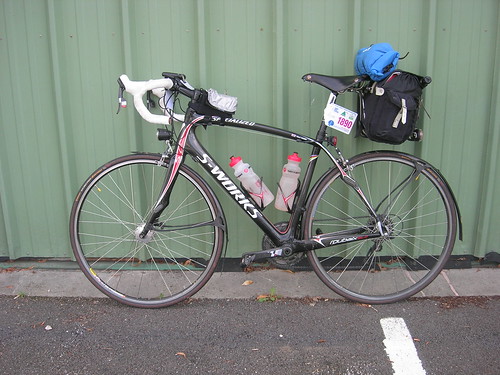In reply to G3CWI:
Hi Richard,
I’m more a cyclist than a SOTA activator, but did do three summits in one day using one of my road bikes - 108 miles and 6000ft of ascent in under 12 hours.
http://haigh.org/cycling/
For these activations I could get the bike right up to the trig point (perhaps with a little pushing due to poor surfaces). A proper road bike does mean you can cover the distances better, but depending upon your bike it can be harder to carry equipment.
You don’t say what your bike is, but if you mean a full-on racing bike it is less likely to have rack mounting points than the Audax bike I used (which is optimised for fast touring so can fit mudguards and very light racks). Personally I hate to have anything on my back when cycling, both from a comfort and a safety point of view. It is far better to put the gear into a pannier if you can fit one. For some panniers, notably Ortlieb, you can get a rucksack style harness for carrying off the bike - though this isn’t as good as a proper rucksack. I guess the choice depends upon if you’ll be spending more time riding the bike or off it - whatever you do will be a compromise.
An alternative if your bike doesn’t have mount points is something like the Carradice Bagman rack which attaches to your saddle rails and will properly support a saddlebag. An alternative from Carradice is the SQR quick release system that mounts on the seat post, but it isn’t to be recommended if your bike has a carbon fibre seat post. The SQR uplift takes a standard saddle bag, or you can get specific bags like the SQR Tour that would be big enough to hold a moderate sized radio, batteries etc. The SQR Tour does have D rings that you can attach a shoulder strap to, but I wouldn’t want to carry it far that way - definitely one for an activation where you can get the bike to the summit or very close.
I like Carradice stuff as it is all made in Nelson, Lancashire, by ladies who sign their names onto the labels. If you have any trouble, you can telephone the manufacturer and they deal with it like a good business should. They are the bags of choice for many serious commuters and long distance riders.
Here’s my race bike with a Carradice Nelson Longflap bag on a bagman when I was taking part in Paris-Brest-Paris in 2011 (720 miles, 3 days, unsupported) to show how you can fit luggage to a bike that hasn’t been designed to carry it.

At the back of the saddlebag you can see a black pump. it’d be possible to safely put poles/elements up to about 18 inches long in that position - typical road bike handlebars are 42-44 cm wide. I think you may know someone who could put together a set of poles and a little beam in this size  Alternatively longer poles can be strapped to the top tube - either above or below depending upon the cable run (you don’t want down the side as that could rub your legs).
Alternatively longer poles can be strapped to the top tube - either above or below depending upon the cable run (you don’t want down the side as that could rub your legs).
Where I’ve got a sleeping bag in a dry bag strapped to the top, you could roll up a daysack and transfer your kit from the saddlebag once you get to the hill.
For security locking the bike up, the best method is to have two independent locks, on cable and one D lock. Make sure both go through the frame, and one around each wheel. One or both should go around an immovable object. The reason for taking two is that typically scroats go equipped with either a mini bottle jack (for cracking D locks) or cutters (for cables), but it isn’t usual for them to carry both - unless it’s a professional team in which case you’ve lost the bike anyway. Plan B is to leave your bike next to a much more desirable one that has worse locks!
I like the Kryptonite Evolution Mini D lock - it is small (easy to carry and difficult to get a jack inside) )and with a good enough security rating that I’ll leave my S-Works Roubaix locked with it short periods in moderate areas.
73, Matt G7GCR
